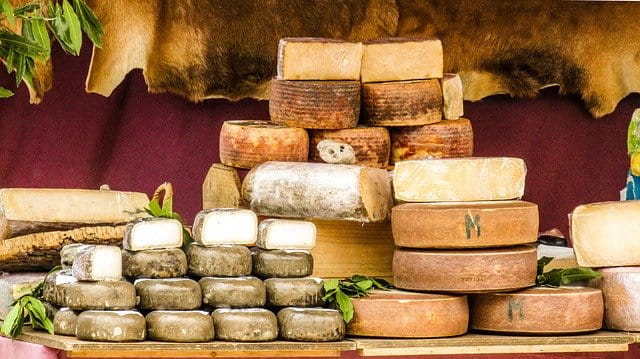Cheese is a versatile food and a popular ingredient known to add flavor to various dishes. You can add it to pizza, pasta, pastries, sandwiches and many other dishes. You can also eat it with fruits, nuts and wine.
However you use cheese, you have to make sure that what you are using is fresh. Cheese is typically aged (depending on the cheese, aging may take a few weeks to as long as a year), so to avoid confusion, when we say fresh in this article, we are talking about the state when the cheese is still at its prime quality.
Fresh cheese tastes better and contains higher nutritional value compared to one that has been left in the fridge for a long time. Ideally, you should only buy cheese that you can consume in a few days. However, some of us may not always have the time to drop by our favorite artisan shops to get the slices of cheese we need; hence, storing cheese becomes a necessity.
The good news is you can retain the freshness of cheese with proper wrapping and storage.
How to Properly Wrap Cheese
One very important thing to remember in wrapping cheese is to steer clear of plastic wraps. Cheese is fermented with different kinds of bacteria. It sweats, breathes and ages. Plastic wraps prevent the cheese from taking in oxygen, making it suffocate. When this happens, its flavor goes bad and it may not live up to the date on the expiration label.
Using cheese wrapping paper keeps your cheese fresh longer and prevents it from tasting like plastic. Cheese wrapping papers are coated with wax and polyethylene that absorbs excess moisture from the cheese, allowing it to breathe but protecting it from drying out. A cheese wrapping paper also promotes good bacteria growth, letting the cheese age just as it would in a cave. Investing in a good cheese wrapping paper will allow you to store your cheese longer.
Step by Step Guide in Wrapping Cheese
There are three common cuts of cheese: wedge, triangular, and pyramid.
 Wrapping Square and Wedge Cheese
Wrapping Square and Wedge Cheese
Step 1: Cut off a large square of wrapping paper that is two or three times larger than the size of your cheese.
Step 2: Place the cheese in the middle of your wrapping paper, making sure that the bottom edge of the cheese is parallel to the bottom edge of the sheet.
Step 3: Pull up the spot of the top and bottom sides and align them.
Step 4: Since one side of the cheese is taller, do the first fold of the paper at an angle. The folded edge must be parallel to the sloping edge of the cheese.
Step 5: Crease the paper and repeat fold until it is neat and tight against the cheese.
Step 6: Fold the corners down and tuck the end under the cheese. Turn the piece around and fold it under.
In this wrapping technique, the weight of the cheese keeps it wrapped, so you don’t have to use tape.
 Wrapping Triangular Cheese
Wrapping Triangular Cheese
Step 1: Put the cheese at the middle of the large cheese wrapping paper and fold the paper over the cheese. Press it gently over the piece and fold the paper over the nose.
Step 2: Bring the paper on top of your piece. Turn it around and keep the back edges down.
Step 3: Crease to keep the paper in place. Finally, flip the cheese over.
 Wrapping Pyramid or Conical Cheese
Wrapping Pyramid or Conical Cheese
Step 1: Place the cheese at the center of the paper bottom side up.
Step 2: Bring the two sides of the paper up. Fold and crease for the wrapping paper to stay neatly in place.
Step 3: Turn the cheese over. Fold the ends by folding one corner at a time and tucking it under the cheese.
Ideal Wrapping Papers for Different Kinds of Cheese
Cheese comes in different varieties. There are hard, semi-hard and soft cheeses. These cheeses vary not only in texture but in taste and quality as well. There are also different kinds of cheese wraps designed to maintain the quality and freshness of various types of cheese.
White molded cheeses, Camembert, Brie, and soft-ripened goat cheese is best wrapped in micro-perforated cheese paper. This wrapper has two layers. The inner layer is paraffin coated while the outer layer is opaque white polypropylene paper. This would allow you to store your cheese over a 6 to 10 week period.
Unperforated cheese wrap is best for blue cheeses like Gorgonzola, Stilton and Roquefort because it allows your cheese to age with control of the rind. Unperforated wraps have a protective white layer on the inside especially designed for blue cheese to age naturally.
A specially designed micro-perforated cheese wrap should be used for washed rind cheeses like Gruyere, Stinking Bishop and Reblochon. This washed rind wrap has two layers (semi-opaque and gloss) that controls the maturation of washed rind cheeses.
Visit the Cheese Kettle shop to explore more types of wrapping paper for your cheese.
Tips in Storing Cheese at Home
Keeping cheese fresh in the refrigerator is a lot easier than most people think. You only need to provide your cheese with three things: the right temperature (40-450 F), the right humidity, and access to oxygen. Here are some tips on how you can keep your cheese fresh as you store it at home.
1. Store the cheese in the vegetable box or cheese box in your fridge. The temperature in this area is cool and stable.
2. You may freeze the cheese if you need to, but freezing affects its taste and texture. Cheese that has been frozen and thawed does not make a delectable addition to the cheese board. It is best to use these for cooking only.
3. Cheese easily absorbs aroma, so store your cheese away from aromatic food.
4. Every time you take your cheese out of the fridge to get a portion of it, re-wrap it in a new sheet of cheese wrapping paper.
5. Semi soft, soft and stinky cheeses should be placed in a resealable plastic container.
6. Fresh cheeses in water should be left in their original containers. Change the brine only if it gets contaminated with a spoon or hand. You can make your own brine by dissolving 1 tablespoon of salt in 3 cups of water. Make sure you don’t use fresh water instead of brine. Water dilutes the flavor of the cheese and makes it spoil faster.
Following these suggestions will help you ensure that your cheese retains its freshness, allowing you to savor its optimal taste and texture even when you’ve stored it in your fridge for a period.
Read the articles below to learn more about keeping your cheese fresh.
How to Keep Cheese Fresh and Mold Free

